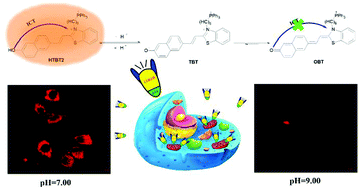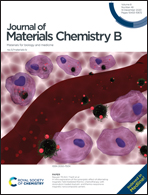A benzothiazolium-based fluorescent probe with ideal pKa for mitochondrial pH imaging and cancer cell differentiation†
Abstract
A mitochondrial pH sensing fluorescent probe namely 2-(2-(6-hydroxynaphthalen-2-yl)vinyl)-3-(6-(triphenyl-phosphonio)hexyl)benzothiazol-3-ium bromide (HTBT2) was designed and facilely synthesized via the Knoevenagel condensation reaction. HTBT2 displayed a linear fluorescence enhancement at 612 nm in response to pH changes between 8.70 and 7.20. The pKa value was determined to be 8.04 ± 0.02, which might be ideal for mitochondrial pH (pHmito ∼8.0) detection. HTBT2 also exhibited a remarkable large Stokes shift of 176 nm, which could diminish the interference of excitation light. The results of live cell imaging studies suggested that HTBT2 showed excellent targeting ability for mitochondria. Importantly, it was successfully applied to visualize mitochondrial pH changes in live cells and differentiate the pHmito difference between cancer cell lines and normal cell lines. Our results consistently supported that HTBT2 held practical promise for the investigation of physiological processes related to pHmito changes and clinical potential for cancer cell differentiation.

- This article is part of the themed collections: 2020 Journal of Materials Chemistry B most popular articles and Journal of Materials Chemistry B Lunar New Year collection 2021


 Please wait while we load your content...
Please wait while we load your content...